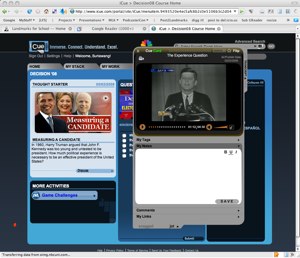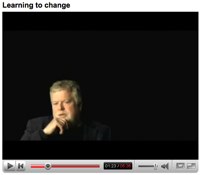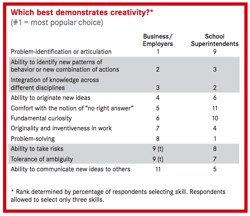 I use to write a lot about the possibilities of fully digital and networked textbooks (or what ever we’ll call them). My ideas were largely speculative — from my own limited imagination. But now, it seems that just about every day I run across some new web application or service that yells at me, “This is what students should be learning from today.”
I use to write a lot about the possibilities of fully digital and networked textbooks (or what ever we’ll call them). My ideas were largely speculative — from my own limited imagination. But now, it seems that just about every day I run across some new web application or service that yells at me, “This is what students should be learning from today.”
The latest was brought to my attention in one of Stephen Downes’ daily jewels entitled iCue. It describes a new product (iCue), resulting from a partnership between NBC and MIT. From Stephen’s post:
This free online platform is targeted to students and lifelong learners ages 13 and up and features patented technology to engage students in collective, problem-solving gaming oriented to core curriculum (U.S. History, Government and Politics and Language Arts).
The basis of this site (according to the tour page) is the Cue Card, which houses an assortment of searchable and organizable video clips from the NBC News Archives regarding the current and past campaigns. Each clip is housed in an interesting tool that wraps around it: discussion, note-taking, personal tagging, video transcript, and background information, including description, source, and keywords. Snagged video cards are stored in a personal archive, and archives can be shared with friends.
There is a lot of Social Network in this tool with a fairly facebook-modeled profile page and discussion forums for “safe” online conversations. The site also provides daily “thought starters” aimed at what is currently in the news.
There are also some interesting games integrated into iCue. Timeline asks you to select from a bin of video cards, arranging them in chronological order. There is also a classic, Concentration. But the twist is that the player must match videos with other videos that are related through with similar keywords.
The most interesting game, to me, is Connection. You are given two unrelated video cards, and must connect them by selecting related cards from a bin, working your way to a connection.
It is a very cool tool related to what has become a wholly uninspiring topic. The first video that I selected featured an interview with one of the presidential candidates, conducted by an interviewer who seemed to think that we’re all hard-of-hearing. The questions consisted of repeated accusations regarding the candidates character, after the interviewer had expressed regret over the campaign’s inability to get to the issues. It all seems aimed toward people who would rather act emotionally than intelligently. ..and I’m not knocking emotion. But I’ve also not been drawn to pay a lot of attention to this years campaigns.
I have to confess that as I started researching the candidates (at 2:15AM) for today’s North Carolina Primary, I felt more confident in the coverage by Wikipedia than just about anything else I looked at — and I’m not sure why. Perhaps it’s because, of all of the sources I found, Wikipedia was the only site that was juried in some way.

 Learning to Change
Learning to Change The first thing I want to do, when I hear something like this is to go find it — the source. It didn’t take very long. I added some key words from the statement, and hyphened out some words that were getting in the way, and came up with a PDF,
The first thing I want to do, when I hear something like this is to go find it — the source. It didn’t take very long. I added some key words from the statement, and hyphened out some words that were getting in the way, and came up with a PDF,  It’s
It’s  I’m working on a little AUP project and have been going through various examples, reading things like:
I’m working on a little AUP project and have been going through various examples, reading things like:









